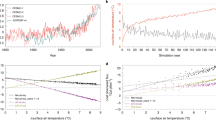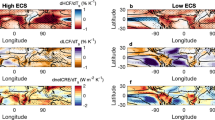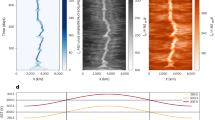Abstract
Equilibrium climate sensitivity refers to the ultimate change in global mean temperature in response to a change in external forcing. Despite decades of research attempting to narrow uncertainties, equilibrium climate sensitivity estimates from climate models still span roughly 1.5 to 5 degrees Celsius for a doubling of atmospheric carbon dioxide concentration, precluding accurate projections of future climate. The spread arises largely from differences in the feedback from low clouds, for reasons not yet understood. Here we show that differences in the simulated strength of convective mixing between the lower and middle tropical troposphere explain about half of the variance in climate sensitivity estimated by 43 climate models. The apparent mechanism is that such mixing dehydrates the low-cloud layer at a rate that increases as the climate warms, and this rate of increase depends on the initial mixing strength, linking the mixing to cloud feedback. The mixing inferred from observations appears to be sufficiently strong to imply a climate sensitivity of more than 3 degrees for a doubling of carbon dioxide. This is significantly higher than the currently accepted lower bound of 1.5 degrees, thereby constraining model projections towards relatively severe future warming.
This is a preview of subscription content, access via your institution
Access options
Subscribe to this journal
Receive 51 print issues and online access
$199.00 per year
only $3.90 per issue
Buy this article
- Purchase on Springer Link
- Instant access to full article PDF
Prices may be subject to local taxes which are calculated during checkout





Similar content being viewed by others
References
Hegerl, G. C. & Zwiers, F. W. Working Group I: The Physical Science Basis of Climate Change Ch. 9, 663–745 (Cambridge Univ. Press, 2007)
Cess, R. D. et al. Intercomparison and interpretation of climate feedback processes in 19 atmospheric general circulation models. J. Geophys. Res. 95, 16601–16615 (1990)
Dufresne, J. L. & Bony, S. An assessment of the primary sources of spread of global warming estimates from coupled atmosphere-ocean models. J. Clim. 21, 5135–5144 (2008)
Soden, B. J. et al. Quantifying climate feedbacks using radiative kernels. J. Clim. 21, 3504–3520 (2008)
Zelinka, M., Klein, S. & Hartmann, D. Computing and partitioning cloud feedbacks using cloud property histograms. Part I: cloud radiative kernels. J. Clim. 25, 3715–3735 (2012)
Hartmann, D. L. & Short, D. A. On the use of earth radiation budget statistics for studies of clouds and climate. J. Atmos. Sci. 37, 1233–1250 (1980)
Bony, S. & Dufresne, J. L. Marine boundary layer clouds at the heart of tropical cloud feedback uncertainties in climate models. Geophys. Res. Lett. 32, L20806 (2005)
Rieck, M., Nuijens, L. & Stevens, B. Marine boundary-layer cloud feedbacks in a constant relative humidity atmosphere. J. Atmos. Sci. 69, 2538–2550 (2012)
Stevens, B. On the growth of layers of nonprecipitating cumulus convection. J. Atmos. Sci. 64, 2916–2931 (2007)
Yano, J. & Emanuel, K. An improved model of the equatorial troposphere and its coupling with the stratosphere. J. Atmos. Sci. 48, 377–389 (1991)
Sherwood, S. C. & Meyer, C. L. The general circulation and robust relative humidity. J. Clim. 19, 6278–6290 (2006)
Allen, M. R. & Ingram, W. J. Constraints on future changes in climate and the hydrologic cycle. Nature 419, 224–232 (2002)
Zhang, C. D., Nolan, D. S., Thorncroft, C. D. & Nguyen, H. Shallow meridional circulations in the tropical atmosphere. J. Clim. 21, 3453–3470 (2008)
Nolan, D. S., Powell, S. W., Zhang, C. D. & Mapes, B. E. Idealized simulations of the Intertropical Convergence Zone and its multilevel flows. J. Atmos. Sci. 67, 4028–4053 (2010)
Rio, C., Hourdin, F., Grandpeix, J. Y. & Lafore, J. P. Shifting the diurnal cycle of parameterized deep convection over land. Geophys. Res. Lett. 36, L07809 (2009)
Soden, B. J. & Vecchi, G. A. The vertical distribution of cloud feedback in coupled ocean-atmosphere models. Geophys. Res. Lett. 38, L12704 (2011)
Soden, B. J. & Held, I. M. An assessment of climate feedbacks in coupled ocean-atmosphere models. J. Clim. 19, 3354–3360 (2006)
Webb, M. & Lock, A. Coupling between subtropical cloud feedback and the local hydrological cycle in a climate model. Clim. Dyn. 41, 1923–1939 (2013)
Brient, F. & Bony, S. Interpretation of the positive low-cloud feedback predicted by a climate model under global warming. Clim. Dyn. 40, 2415–2431 (2013)
Held, I. M. & Soden, B. J. Robust responses of the hydrological cycle to global warming. J. Clim. 19, 5686–5699 (2006)
Zahn, M. & Allan, R. P. Climate warming-related strengthening of the tropical hydrological cycle. J. Clim. 26, 562–574 (2013)
Klein, S. A. et al. Are climate model simulations of clouds improving? An evaluation using the ISCCP simulator. J. Geophys. Res. 118, 1329–1342 (2013)
Volodin, E. M. Relation between temperature sensitivity to doubled carbon dioxide and the distribution of clouds in current climate models. Izv. Atmos. Ocean. Phys. 44, 288–299 (2008)
Clement, A. C., Burgman, R. & Norris, J. R. Observational and model evidence for positive low-level cloud feedback. Science 325, 460–464 (2009)
Fasullo, J. T. & Trenberth, K. E. A less cloudy future: the role of subtropical subsidence in climate sensitivity. Science 338, 792–794 (2012)
Webb, M. J., Lambert, F. H. & Gregory, J. M. Origins of differences in climate sensitivity, forcing and feedback in climate models. Clim. Dyn. 40, 677–707 (2013)
Vial, J., Dufresne, J.-L. & Bony, S. On the interpretation of inter-model spread in CMIP5 climate sensitivity estimates. Clim. Dyn. 41, 3339–3362 (2013)
Randall, D. A. & Wood, R. A. Working Group I: The Physical Science Basis of Climate Change Ch. 8, 589–662 (Cambridge University Press, 2007)
Taylor, K. E., Stouffer, R. J. & Meehl, G. A. An overview of CMIP5 and the experiment design. Bull. Am. Meteorol. Soc. 93, 485–498 (2012)
Gregory, J. M. et al. A new method for diagnosing radiative forcing and climate sensitivity. Geophys. Res. Lett. 31, L03205 (2004)
Forster, P. M. et al. Evaluating adjusted forcing and model spread for historical and future scenarios in the CMIP5 generation of climate models. J. Geophys. Res. 118, 1139–1150 (2013)
Uppala, S. M. et al. The ERA-40 re-analysis. Q. J. R. Meteorol. Soc. 131, 2961–3012 (2005)
Rienecker, M. M. et al. MERRA: NASA's modern-era retrospective analysis for research and applications. J. Clim. 24, 3624–3648 (2011)
Sherwood, S. C., Meyer, M. L., Allen, R. J. & Titchner, H. A. Robust tropospheric warming revealed by iteratively homogenized radiosonde data. J. Clim. 21, 5336–5352 (2008)
Sherwood, S. C., Roca, R., Weckwerth, T. M. & Andronova, N. G. Tropospheric water vapor, convection and climate. Rev. Geophys. 48, RG2001 (2010)
Acknowledgements
This work was supported by the FP7-ENV-2009-1 European project EUCLIPSE (number 244067). We acknowledge the World Climate Research Programme’s Working Group on Coupled Modelling, which is responsible for CMIP, and we thank the climate modelling groups for producing and making available their model output, especially the participants contributing additional CFMIP2 experiments and diagnostics crucial to our study. The US Department of Energy’s Program for Climate Model Diagnosis and Intercomparison provides coordinating support for CMIP and led the development of software infrastructure in partnership with the Global Organisation for Earth System Science Portals. We also thank the National Center for Atmospheric Research and the Earth System Grid Federation for providing access to PCM output, the Australian National Computational Infrastructure, and the IPSL Prodiguer-Ciclad facility for providing a convenient archive of CMIP data. Finally, we thank B. Stevens, C. Bretherton and G. Schmidt for comments on early versions of the manuscript.
Author information
Authors and Affiliations
Contributions
S.C.S. led the study and the writing of the paper, and did the calculations of LTMI and related diagnostics. S.B. computed cloud radiative effect and assisted in interpreting results and writing the paper. J.-L.D. computed ECS and assisted in interpreting results and writing the paper.
Corresponding author
Ethics declarations
Competing interests
The authors declare no competing financial interests.
Extended data figures and tables
Extended Data Figure 1 Illustration of atmospheric overturning circulations.
Deep overturning strongly coupled to the hydrological cycle and atmospheric energy budget is shown by solid lines; lower-tropospheric mixing is shown by dashed lines. The MILC feedback results from the increasing relative role of lower-tropospheric mixing in exporting humidity from the boundary layer as the climate warms, thus depleting the layer of water vapour needed to sustain low cloud cover.
Extended Data Figure 2 Small-scale moisture source Msmall.
Vertical profile averaged over all tropical oceans, for two selected climate models (see legend) with very different warming responses, in present-day (solid) and +4 K (dashed) climates.
Extended Data Figure 3 Response of cloud fraction to warming.
Profile of average change in model cloud fractional cover at +4 K in the four atmosphere models with largest (magenta) and smallest (blue) estimated +4 K increases in planetary-boundary-layer drying, averaged from 30° S to 30° N (dashed) or 60° S to 60° N (solid). The drying estimate is obtained by adding the explicitly computed change in MLT, large to the change in Msm estimated from S via the relationship shown in Fig. 2a. The typical mean cloud fraction below 850 hPa is about 10% to 20%, and the changes shown are absolute changes in this fraction, so are of the order of 10% of the initial cloud cover.
Extended Data Figure 4 Response of large-scale lower-tropospheric mixing to warming.
Profiles of mean vertical velocity in regions of shallow ascent, in control and +4 K climates. The similarity of dashed and solid lines indicates that mass overturning associated with these regions is roughly the same in the warmer simulations, on average.
Extended Data Figure 5 Response of small-scale, low-level drying to warming.
Change in convective moisture source Msmall below 850 hPa upon a +4 K warming in eight atmosphere models and one CMIP3 coupled model; units are W m−2, with negative values indicating stronger drying near the surface. Zero contours are shown in white (a few off-scale regions also appear white). The models used for calculating Mlarge are the eight shown here plus two for which Msmall data were unavailable: CNRM-CM5 and FGOALS-g2.
Source data
Rights and permissions
About this article
Cite this article
Sherwood, S., Bony, S. & Dufresne, JL. Spread in model climate sensitivity traced to atmospheric convective mixing. Nature 505, 37–42 (2014). https://doi.org/10.1038/nature12829
Received:
Accepted:
Published:
Issue Date:
DOI: https://doi.org/10.1038/nature12829
This article is cited by
-
Constrained tropical land temperature-precipitation sensitivity reveals decreasing evapotranspiration and faster vegetation greening in CMIP6 projections
npj Climate and Atmospheric Science (2023)
-
Intermodel relation between present-day warm pool intensity and future precipitation changes
Climate Dynamics (2023)
-
Observations refute the idea that warming strongly reduces cloudiness
Nature (2022)
-
Present-day warm pool constrains future tropical precipitation
Communications Earth & Environment (2022)
-
Model spread in tropical low cloud feedback tied to overturning circulation response to warming
Nature Communications (2022)
Comments
By submitting a comment you agree to abide by our Terms and Community Guidelines. If you find something abusive or that does not comply with our terms or guidelines please flag it as inappropriate.



